| Back to Back Issues Page |
 |
|
Bangkok Travelbug October 11 – Laem Sing, Chanthaburi – the Lion Cape September 28, 2011 |
| Hello
About Laem Sing Laem Sing district is about 30 km south of the Chanthaburi city. It’s located at the estuary of the Chanthaburi River which dissects the eastern part of the province, passes through Chanthaburi city before flowing out to the Gulf of Thailand. 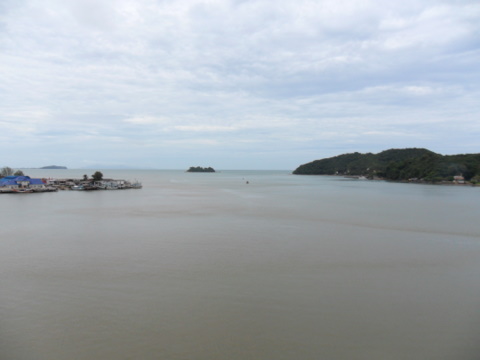
The Chanthaburi estuary, Laem Sing is to the left (east) and Laem Sing Forest Park to the right (west) Laem Sing got its name from a huge rock at the estuary that resembled a lion. As the rock was on the tongue of land protruding from the east bank of the estuary, the place was called Laem Sing or Lion Cape. 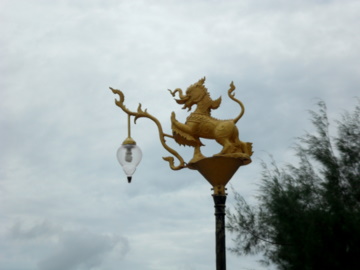
The lion reigns supreme There’s a fishing port at the tip of the cape where fishing boats off-load their catch into a conveying belt where fish are packed into foam boxes for the market. 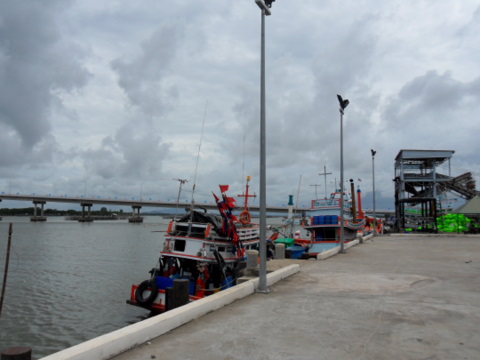
Fishermen’s wharf The major attractions at the Chanthaburi River estuary are the beautiful Laem Sing beach on the east bank and the Laem Sing Forest Park on the west. There are also two small off-shore islands; Ko Chula (Chula Island) and Ko Nom Sao (Maiden’s Breasts Island, don’t ask me why). 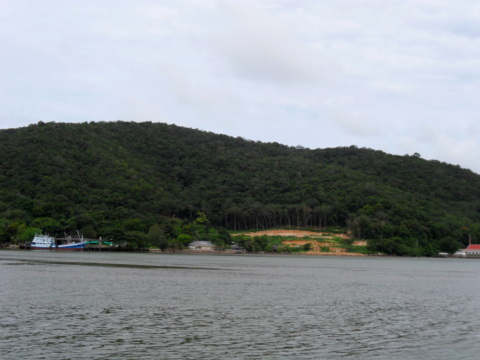
Laem Sing Forest Park just across the estuary It was peaceful on the beach that morning as we were the only visitors there. The beach caters mainly to weekend visitors from the city. 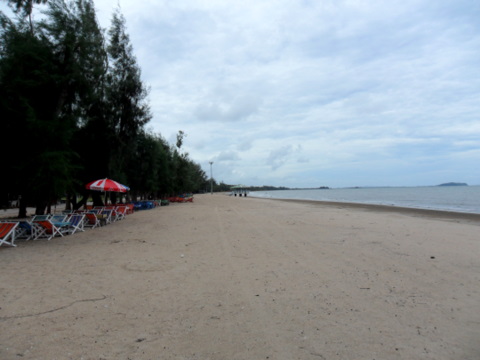
Laem Sing beach on a weekday Table of contents Laem Sing in Thai history The costly war with Vietnam over control of Cambodia in the reign of King Rama III dragged on intermittently from 1833 till it was finally over in 1846 when Thailand was firmly control of Cambodia. As Laem Sing was at the river mouth, two forts were built to prevent a Vietnamese incursion by sea and up the Chanthaburi River. Only the ruins of one fort remain today. The end of the 19th C gave rise to a new conflict, this time with the French colonialists in Indochina. When the territorial conflict erupted in Laos in 1893, French retaliated by sending gunboats up the Chao Phraya River to threaten Bangkok. A blockade was also imposed at Paknam the river mouth. Thailand was forced to give up Laos and pay a heavy indemnity of 3 million francs. To ensure that these demands were met, the French occupied Chanthaburi and Trat from 1893 – 1906. A further demand was a 25 km demilitarised zone west of the Mekong which prevented Thailand from deploying troops in her own territory! It was a dark period in Thai history and there remains a grim reminder of the French occupation in Chanthaburi. For more on the Franco-Siamese conflict, please see Paknam - the forts of crouching tigers Table of contents Tuek Daeng – the Red Building The red single-storey building 200 m away from the estuary and fishing port was closed during my visit. There were no signboards to indicate what the building is being currently used for. 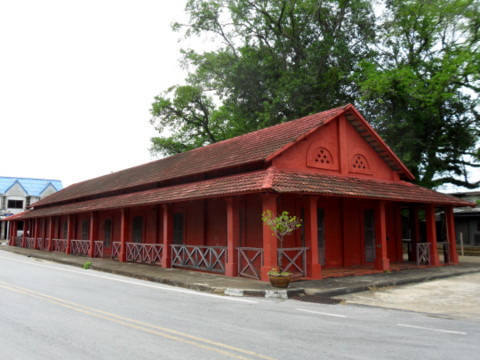
Tuek Daeng The building is called Tuek Daeng, literally "red building" and it stands over the site of an old fort that is no longer exists. That fort, Pom Phikat Patchamit is one of the pair of forts guarding the river mouth. During the French occupation, Tuek Daeng was used as quarters for French officers. It’s a pity; Tuek Daeng would be ideal as a museum to preserve the history of Laem Sing. Table of contents Fort Phairi Phinat We crossed the long bridge at the estuary linking Laem Sing to the Laem Sing Forest Park on the west bank. 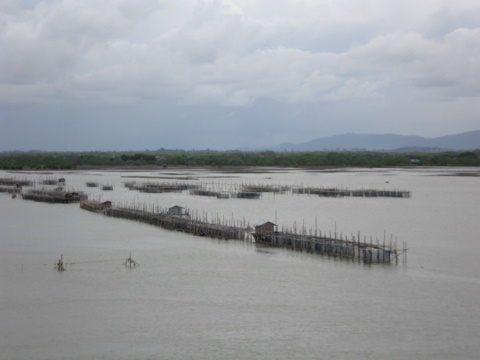
Kelongs (wooden stilts and platforms for trapping fish) in the estuary When we got to the other side, we turned left and followed the road signs along the hilly road until we got to this stone path. 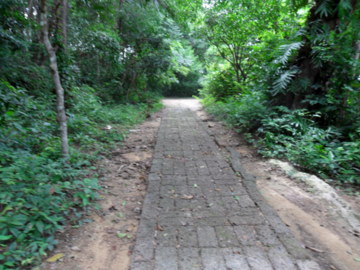
The way in From there on we had to proceed on foot up a flight of stone steps which soon gave way to mere tree roots. 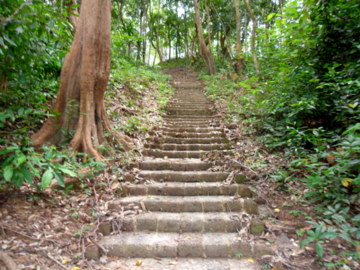
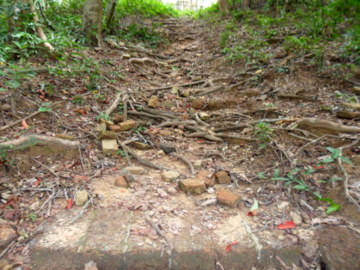
The way up Little remains of the old fort except stone stumps. The fort was built in 1834 in the reign of King Rama III to counter a Vietnamese naval threat. It was only in 1857 during a royal visit by King Rama IV that the fort was named Pom Phairi Phinat or Fort Phairi Phinat. 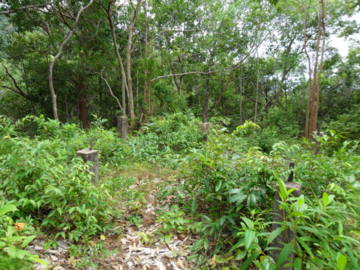
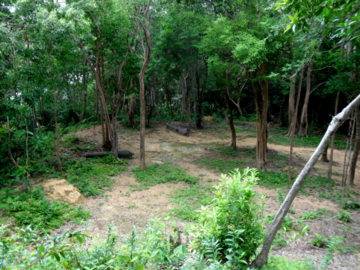
What little remains of the fort It’s one of the pair of forts guarding the entrance to the estuary, the other being, Pom Phikat Patchamit in Laem Sing. That fort however was completely destroyed and Tuek Daeng, the red building stands on the site. I cautiously peeked into what looked like a concrete bunker. But it was just a small space probably for ammunition storage. 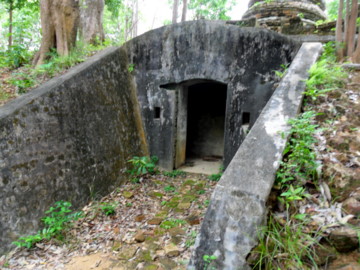
Entrance to the magazine But the structure that caught my eye was up on a hillock in the centre of the ruins. It was an old crumbling chedi on the verge of collapse, held up by timbers. This chedi was built in 1904 at Fort Phairi Phinat to celebrate the signing of the treaty for the French withdrawal from Chanthaburi. It was built on the site of an old chedi built earlier by the Governor of Trat. 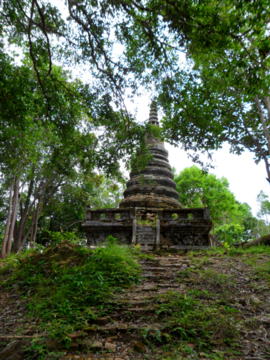
Chedi Issaraparb Appropriately the new chedi was named Chedi Issaraparb or the Freedom Chedi. Despite the 1904 treaty, the French didn’t withdraw from Chanthaburi until 1906. 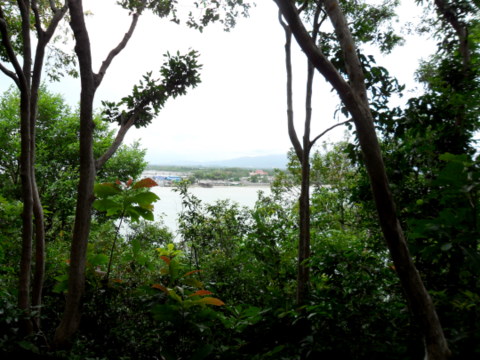
View of Laem Sing from Fort Phairi Phinat Table of contents Khuk Khi Kai The French occupation of Chanthaburi was naturally met with resentment and resistance. Some openly rebelled. Those who were caught were thrown into this prison which was built in 1893. 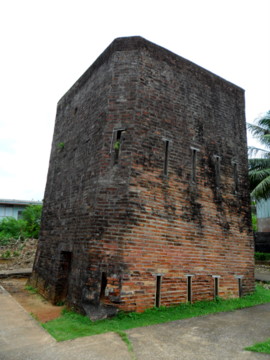
Khuk Khi Kai The prison consisted of a brick tower 4.4 m square and 7 m high with two rings of ventilation slots around the tower. One had to bend to get in the low, narrow door at one side. 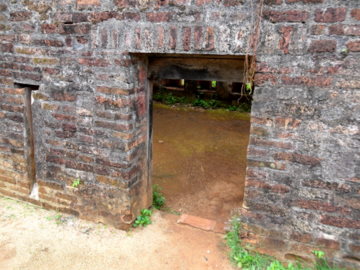
The door to the prison 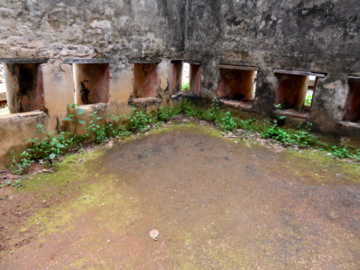
Inside the prison The top of the tower however was open and it wasn’t for ventilation. Wire mesh was placed over the top of the tower where chickens were reared. The chicken droppings fell constantly on the prisoners below, adding to the misery of their imprisonment. 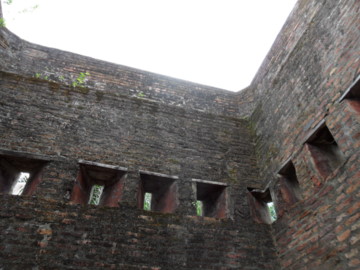
Imagine being locked up here with chickens above I have no idea what the French called this prison. But the Thais gave it a name to ensure that posterity will not forget the inhuman treatment the French meted out to their captives. They called the prison Khuk Khi Kai or prison of chicken droppings. 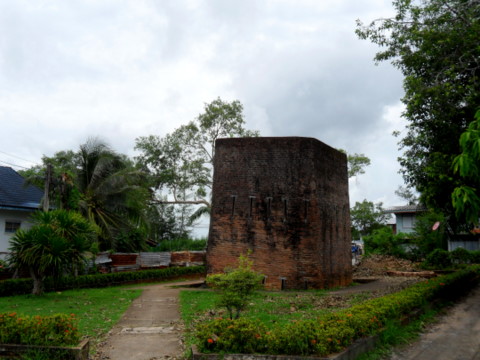
A grim reminder of the past This signboard just next to the old prison site, adds the final twist of irony. 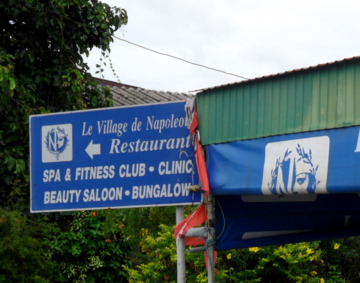
Table of contents Map of Laem Sing View Laem Sing Chanthaburi in a larger map Switch to the satellite or Google Earth version on the map to get a 3D view of the places. How to get there To get to Chanthaburi city take a van from the Victory Monument in Bangkok. The van station is near the junction of Soi Ratchawithi 10 where the Fashion Mall is located. The fare one way is 200 baht. The van will go all the way to the Chanathaburi city centre and terminate at the station behind KP Grand Hotel.
|
| Back to Back Issues Page |
